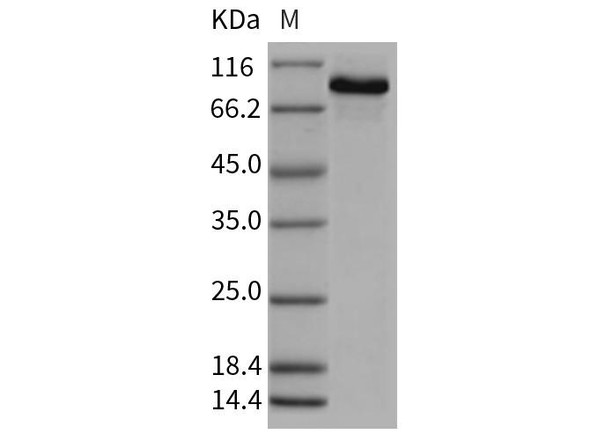Description
| Product Name: | Mouse Transferrin/TF Recombinant Protein (His tag) |
| Product Code: | RPES6112 |
| Size: | 20µg |
| Species: | Mouse |
| Expression Host: | HEK293 Cells |
| Synonyms: | Serotransferrin, Transferrin, Beta-1 metal-binding globulin, Siderophilin, Trf |
| Mol Mass: | 76.56 kDa |
| AP Mol Mass: | 70 kDa |
| Tag: | C-His |
| Purity: | > 95 % as determined by reducing SDS-PAGE. |
| Endotoxin Level: | Please contact us for more information. |
| Bio Activity: | Testing in progress |
| Sequence: | Met1-His697 |
| Accession: | Q921I1 |
| Storage: | Generally, lyophilized proteins are stable for up to 12 months when stored at -20 to -80°C. Reconstituted protein solution can be stored at 4-8°C for 2-7 days. Aliquots of reconstituted samples are stable at < -20°C for 3 months. |
| Shipping: | This product is provided as lyophilized powder which is shipped with ice packs. |
| Formulation: | Lyophilized from sterile PBS, pH 7.4. Normally 5 % - 8 % trehalose, mannitol and 0.01% Tween80 are added as protectants before lyophilization. Please refer to the specific buffer information in the printed manual. |
| Reconstitution: | Please refer to the printed manual for detailed information. |
| Background: | Transferrin is a glycoprotein with an approximate molecular weight of 76.5 kDa. This glycoprotein is thought to have been created as a result of an ancient gene duplication event that led to generation of homologous C and N-terminal domains each of which binds one ion of ferric iron. The function of Transferrin is to transport iron from the intestine, reticuloendothelial system, and liver parenchymal cells to all proliferating cells in the body. This protein may also have a physiologic role as granulocyte / pollen-binding protein (GPBP) involved in the removal of certain organic matter and allergens from serum. Transferrins are iron binding transport proteins which bind Fe3+ ion in association with the binding of an anion, usually bicarbonate. It is responsible for the transport of iron from sites of absorption and heme degradation to those of storage and utilization. Serum transferrin may also have a further role in stimulating cell proliferation. When a transferrin loaded with iron encounters with a transferring receptor on cell surface, transferring binds to it and, as a consequence, is transported into the cell in a visicle by receptor-mediated endocytosis. The PH is reduced by hydrogen iron pumps. The lower pH causes transferrin to release its iron ions. The receptor is then transported through the endocytic cycle back to the cell surface, ready for another round of iron uptake. Each transferrin molecule has the ability to carry two iron ions in the ferric form. |






